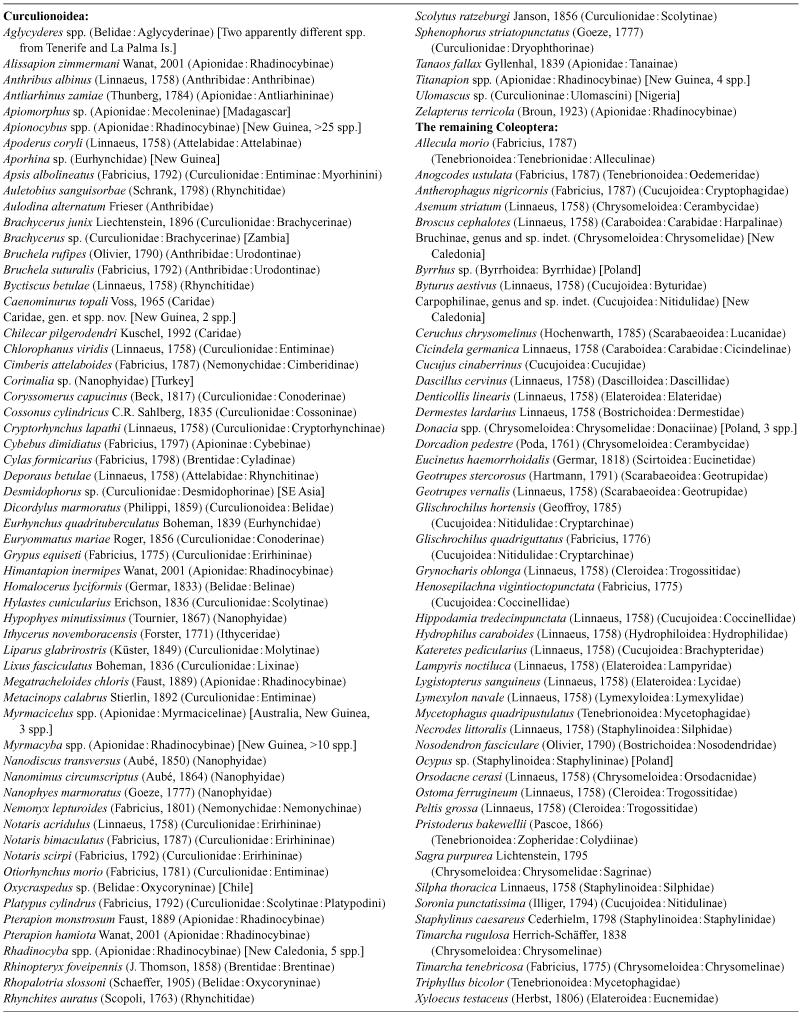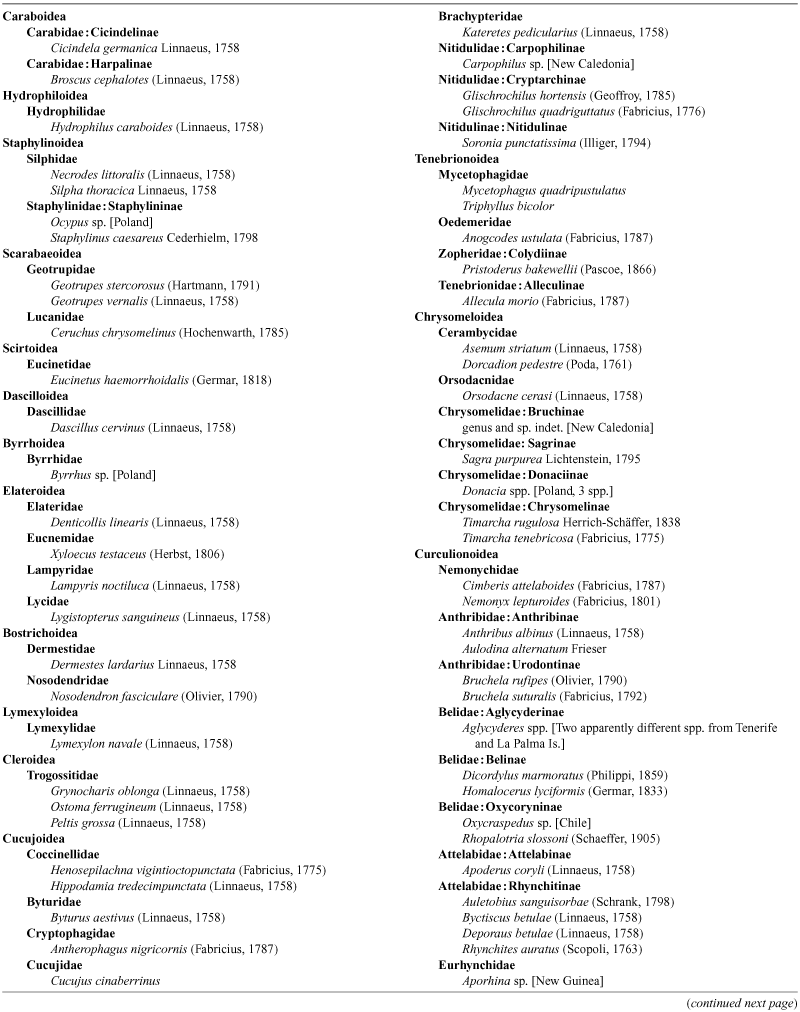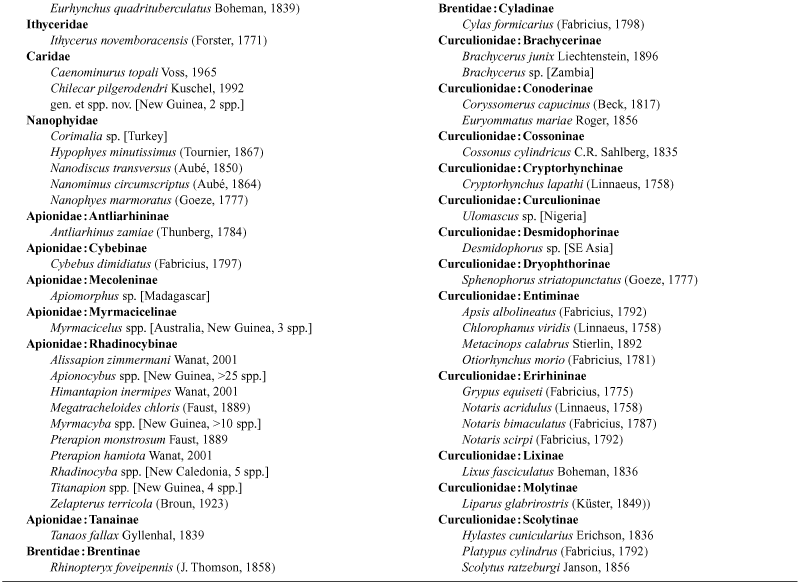Alignment and homology of male terminalia in Curculionoidea and other Coleoptera
Marek WanatA Museum of Natural History, Wrocław University, Sienkiewicza 21, 50-335 Wrocław, Poland.
B Corresponding author. Email: wanatm@biol.uni.wroc.pl
Invertebrate Systematics 21(2) 147-171 https://doi.org/10.1071/IS05055
Submitted: 16 November 2005 Accepted: 30 November 2006 Published: 21 May 2007
Abstract
Male genitalia and associated internal sclerotised plates have been long recognised in beetle taxonomy, but their relative position in the connecting membrane and the genital membrane folding patterns have never been thoroughly investigated. In this study, the structure of the genital chamber in weevils (Curculionoidea) and other Coleoptera has been investigated in detail, focusing primarily on the alignment of the 9th abdominal segment and true genital plates. Three basic types of genital alignment are recognised based on the orientation of sclerotised plates and membrane folding: (1) a primitive eucinetid type (both 9th segment and tegmen non-inverted); (2) a derived phytophagan type (both 9th segment and tegmen inverted) and (3) a cucujid type (9th segment non-inverted, tegmen inverted). A different origin is here postulated for the parameroid plate in Curculionoidea, Chrysomeloidea and a part of the Cucujoidea (from the fold of the membrane linking tergite 9 with the tegmen) and for the true parameres in the remaining Coleoptera (from the fold of the membrane linking the tegmen with the aedeagus); hence these alignment types are considered non-homologous. The superfamily Cucujoidea was found to be heterogeneous with regard to genital alignment and considered polyphyletic. The proctiger and the paraprocts of the beetles are interpreted as belonging to the 9th abdominal segment and no extrategminal plates of the 10th segment were found in Coleoptera. Arguments for and against a hypothetical homology of beetle genitalia with abdominal segments 10 and 11 are discussed.
Acknowledgements
I thank Drs John F. Lawrence, Petr Švácha, Adam Ślipiński, Alfred F. Newton Jr., Jarmila Kukalova-Peck, Michael Ivie, and Janusz Kubrakiewicz for their critical comments on earlier drafts of the manuscript, and the two anonymous referees for the great job they have done and hundreds of suggestions improving the text. Ms Anna Mucha and Dr Łukasz Pasśko are appreciated for their great technical help with the illustrations. I am indebted to Drs Beata M. Pokryszko and Robert A. D. Cameron for their linguistic advice and corrections, and to the editors for their hard work on the final version of the manuscript. Dr Adam Ślipiński is especially acknowledged for his encouragement and advice in selection of the non-weevil taxa for the study, and for the loan of some relevant species. The studies presented herein, as well as the presentation of their preliminary results at the XXII International Congress of Entomology (15–21 August 2004, Brisbane, Australia), were supported by the former State Committee for Scientific Research, currently the Ministry of Scientific Research and Scientific Technology, Poland (grant no. 3 P04C 08223).
Alonso-Zarazaga M. A.
(1983) Studies on Ethiopian Apionidae (Coleoptera). 1. Comments on the genus Apiomorphus Wagner, 1911, with description of a new South African species. Journal of the Entomological Society of Southern Africa 46, 241–247.

Alonso-Zarazaga M. A.
(1989) Revision of the supraspecific taxa in the Palaearctic Apionidae Schoenherr, 1823. 1. Introduction and subfamily Nanophyinae Seidlitz, 1891 (Coleoptera, Curculionoidea). Fragmenta Entomologica 21, 205–262.

Alonso-Zarazaga M. A.
(1990) Revision of the supraspecific taxa in the Palaearctic Apionidae Schoenherr, 1823 (Coleoptera, Curculionoidea). 2. Subfamily Apioninae Schoenherr, 1823: introduction, keys and descriptions. Graellsia 46, 19–156.

Crowson R. A.
(1960) The phylogeny of Coleoptera. Annual Review of Entomology 5, 111–134.
| Crossref | GoogleScholarGoogle Scholar |

Evans M. E. G.
(1961) The muscular and reproductive systems of Atomaria ruficornis (Marsham) (Coleoptera, Cryptophagidae). Transactions of the Royal Society of Edinburgh 64(14), 297–399.

Gønget H.
(1997) The Brentidae (Coleoptera) of northern Europe. Fauna Entomologica Scandinavica 34, 1–289.

Kuschel G.
(1989) The Nearctic Nemonychidae (Coleoptera: Curculionoidea). Entomologica Scandinavica 20, 121–171.

Kuschel G.
(1995) A phylogenetic classification of Curculionoidea to families and subfamilies. Memoirs of the Entomological Society of Washington 14, 5–33.

Leschen R. A. B.,
Lawrence J. F., Ślipiński S. A.
(2005) Classification of basal Cucujoidea (Coleoptera : Polyphaga): cladistic analysis, keys and review of new families. Invertebrate Systematics 19, 17–73.
| Crossref | GoogleScholarGoogle Scholar |

Michener Ch. D.
(1944) A comparative study of the appendages of the eighth and ninth abdominal segments of insects. Annals of the Entomological Society of America 37, 336–351.

Muir F.
(1915) Notes on the ontogeny of the genital tubes in Coleoptera. Psyche [pl. XII.] 22(5), 147–152.

Muir F.
(1918) Notes on the ontogeny and morphology of the male genital tube in Coleoptera. Transactions of the Entomological Society of London 1918, 223–229.

Riedel A.
(1999) The spinosus-group of Euops Schoenherr (Coleoptera: Curculionoidea, Attelabidae), weevils with humeral spines from New Guinea. Entomologica Scandinavica 30, 75–117.

Riedel A.
(2001) Revision of the simulans-group of Euops Schoenherr (Coleoptera, Curculionoidea, Attelabidae) from the Papuan region. Mitteilungen aus dem Museum für Naturkunde in Berlin - Deutsche Entomologische Zeitschrift 48, 139–221.

Sharp D., Muir F.
(1912) The comparative anatomy of the male genital tube in Coleoptera. Transactions of the Entomological Society of London 1912, 477–641.

Snodgrass R. E.
(1931) Morphology of the Insect Abdomen. Part 1. General structure of the abdomen and its appendages. Smithsonian Miscellaneous Collections 85(6), 1–128.

Snodgrass R. E.
(1957) A revised interpretation of the external reproductive organs of male insects. Smithsonian Miscellaneous Collections 135(6), 1–60.

Thompson R. T.
(1992) Observations on the morphology and classification of weevils (Coleoptera, Curculionoidea) with a key to major groups. Journal of Natural History 26, 835–891.
| Crossref | GoogleScholarGoogle Scholar |

Verhoeff C.
(1893) Vergleichende untersuchungen über die abdominalsegmente und die copulationsorgane der männlichen Coleoptera. Deutsche Entomologische Zeitschrift 37, 113–170.

Verma K. K.
(1958) Torsion of the male genitalia of Galerucella birmanica Jac. (Coleoptera, Phytophaga, Chrysomelidae). Annals and Magazine of Natural History 1,, 793–794.

Wilson J. W.
(1930) The genitalia and wing venation of the Cucujidae and related families. Annals of the Entomological Society of America 23, 305–358.

Wood S. L.
(1952) Observations on the homologies of the copulatory apparatus in male Coleoptera. Annals of the Entomological Society of America 45, 613–617.


|

|

|


